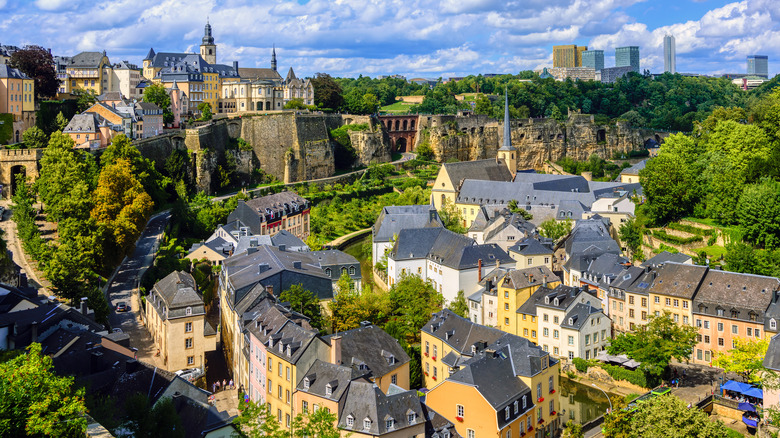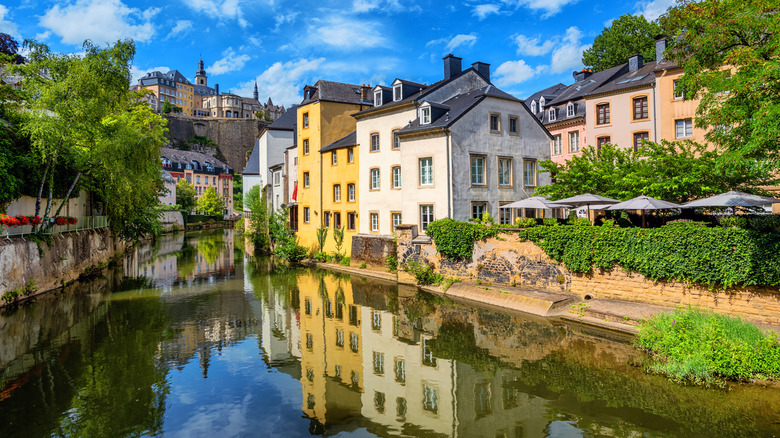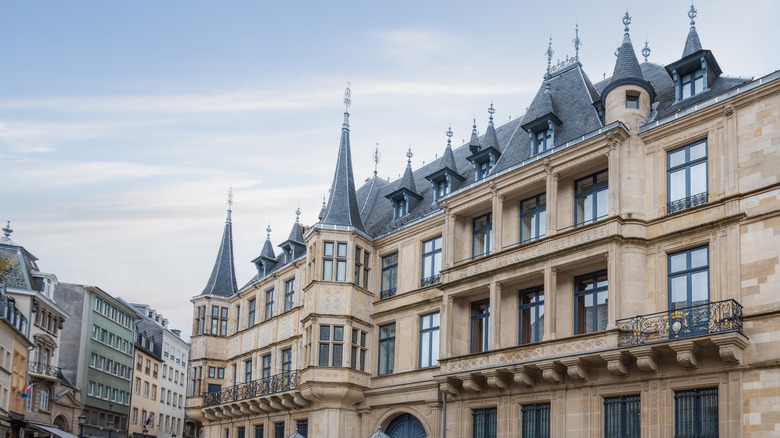This Underrated And Charming Western European City Is A Great Spot For History-Buffs
When you think of cities to visit in Europe, a few major ones come to mind. Perhaps you think of Paris, Rome, or Berlin. Maybe it's Lisbon or Madrid. It's very likely that Luxembourg City isn't one of them. You might not have thought of Luxembourg at all. It's a very small country, nestled where Germany, France, and Belgium meet, and despite its size, it's well worth a visit, especially if you're a history buff. The capital, Luxembourg City, is a UNESCO World Heritage Site, and there is a lot to see.
There have been Roman settlements in the area, where the Alzette and Pétrusse rivers meet, and a small castle was built atop a large hill in the 10th century. A wall around the city was added in the 12th century, and much of the city's old quarter layout and fortifications are the same as they were hundreds of years ago. There is great food, some incredible historical buildings, and even an underground tunnel to visit. It's also considered a very safe place for solo travelers. Let's take a look at Luxembourg City.
What to know about Luxembourg City
There is a lot to see here, like the canals you can walk by, the old town quarter, and the fortress walls used to protect the city. You can sample local foods like bouneschlupp, a green bean and potato soup that is traditional here, with gromperekichelcher, a crisp potato fritter. You cannot leave without trying quetschentaart, a plum tart, washing it down with local schnapps, or a sparkling wine called crémant.
The country takes up only 998 square miles, yet its Gross Domestic Product (GDP) reached an all-time high of $85.51 billion in 2021. It's the only existing Grand Duchy at the moment, meaning a Grand Duke or Grand Duchess runs it. You can visit the beautiful Palace of the Grand Dukes in Luxembourg City during certain times of the year — mid-July through the end of August — and it's still used as the official royal residence.
The city is divided into two parts: the old city on the hill (the Bock) and the lower part (the Grund), which still has many old residences and is a great place to eat and shop. Not only that, but you can take the Pfaffenthal Lift, a glass-bottomed elevator, from the upper city to the lower city. You can also stroll down the Chemin de la Corniche, a balcony walk down the 17th-century city fortifications, which has some spectacular views.
Things to do here
History buffs will find the story of Count Siegfried and Melusine intriguing. Interestingly, variations of this saga appear throughout European folklore. As the tale goes, in 963, Siegfried built the Lucilinburhuc, a small castle on the Bock near an ancient Roman road. His wife, Melusine, required that he give her one day a week alone after marriage. When he finally broke her rule and spied on her, he found she had a mermaid tail. Angered, she jumped out the window of this castle and disappeared. Though regarded as a myth by some, you can tour the remnants of Lucilinburhuc and even see Melusine's pink statue in Luxembourg City.
Underneath the Bock is the Bock Casemates, the tunnels under the former castle built in the mid-18th century. The tunnels have been used for many things; it's been a bakery, a WWII bomb shelter, and a storehouse, and you can walk through part of it on a tour. Another place to check out is Notre Dame de Luxembourg, which began construction in 1613.
Built in late Gothic and Renaissance styles, the church was created by the Jesuits to add to their college. It's known for some beautiful stained glass and bas-relief sculptures. It also houses the remains of the royal family that date back to the 1300s. Finally, if you're interested in later history, stop by the Place de la Constitution to see the memorial to those who died in WWI and later wars.


